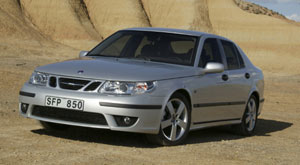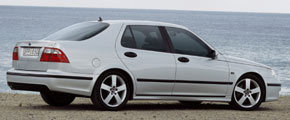|
|
 |
The front-wheel-drive 9-5 Aero has all the comfort one has come to expect from Saab. The car feels solid, heavy, and stuck to the road. It's also quiet, and-like its Saab predecessors - rides and handles very nicely, especially at the speeds which most people actually drive cars. Unlike some other European cars, the Saab is not tuned to impress at 110 mph. It's tuned to perform well at real world speeds. The result is an excellent balance of comfort and sportiness-not to mention control and safety.
Thanks to the turbo and an efficient engine design, Saab was able to squeeze a lot of power out of a relatively small, 2.3-liter engine. In fact, the four-cylinder engine in the 9-5 Aero generates 250 horsepower - as much or more power than a number of larger, six-cylinder engines. The price you pay for this high power/high efficiency engine is a certain amount of turbo lag when starting off. The turbo lag is much better than it used to be, but when the turbo kicks in at, oh, around 2500 rpm, you'd better have your headrest adjusted.
The smooth automatic transmission has a manual option, which Saab calls "Sentronic" (was the alternative "Numbtronic"?). The Aero has shifter buttons on the steering wheel, allowing the driver to shift in manual mode while keeping both hands on the wheel-possibly to help the driver control the torque steer!
Like other Saabs, this car has a high belt line, so there is a bit of a "bathtub" effect when you sit in it. But that creates a feeling of being protected. And you don't just feel safe in this car-you are safe. Saab has a well-earned reputation for safety, and they keep their cars updated with the latest safety technology. The 9-5 Aero has Saab's electronic stability program, which constantly measures the difference between the steering wheel input and where the car is actually going. And when necessary, the program activates individual brakes to prevent the car from spinning or rolling out of control. There are also active head restraints in the front, and front-seat head and side air bags. Then, there's a feeling of safety and security you get from a car that's easy to drive, and confidently does what you expect it to do.
Incidentally, Saabs have traditionally performed well in the snow.
|
|
 |
The inside of the 9-5 feels a bit old. The dashboard comes close to the driver. The windshield is fairly flat. More recently designed cars feel airier, and are often ergonomically sleeker. But there's no doubt that this is a comfortable, even luxurious interior, with great seats and a good driving position. The 9-5 also creates a lot of interior room for its size. Even though this is not a large car overall, room is quite adequate for all major body parts: feet, shoulders and head.
The Aero has more than enough room in the back, where there's plenty of legroom. The only major downside was that the armrest for the front-seat passengers intruded into the legroom for the rear, middle passenger. Otherwise, we thought everything else was well situated in the car.
There's a vent that's right in the console between the seats, which is pretty good for the person sitting in the middle of the back seat, but it doesn't make a lot of air available to passengers sitting to either side.
|
|
 |
In general, the ergonomics in the Aero are pretty good. The driver's seat is cockpit-like, with instrumentation across the front and down the center console. Despite the fact that there are many, initially indistinguishable small buttons on the console, the radio and heat controls were easy to figure out. We liked all the gauges, which were large enough so that those of us who require reading glasses won't have to put on bifocals to drive.
It was refreshing for certain members of our staff to be able to sit behind the wheel, look at a dashboard and be able to read everything without having to use glasses-even in the evening, or other conditions when the light is poor. It may not be a reason to buy the car, but it's an added plus if you're at the age where you have to hold a menu at arms length before deciding what to have for dinner.
The Aero also has a "night panel" feature. Press a button, and everything on the dashboard-the tachometer, the temperature gauge, the fuel gauge, the turbo boost-all go dark, except for the speedometer, which stays illuminated. Interestingly, the speedometer is only illuminated up to 90 miles an hour, which might suggest to you that if it's dark out, you shouldn't go over 90. (Are there really morons out there who need to be reminded of that?) We liked this "night panel" feature - it definitely makes night driving easier on your eyes, by allowing your vision to focus on light that's coming from outside the car. After all, the darker it is inside, the easier it is to see outside. Of course, in almost all cars these days the intensity of the dash illumination can be adjusted. But this is a particularly nice feature for long highway trips taken after dark because everything in the car goes away except for the speedometer. We assume that any warning lights would still come on in night mode (low oil pressure, low fuel, mother-in-law fell out of trunk), but we never had reason to find out. |
|
 |
 The 9-5 is a nice looking car. It's lost some of the quirkiness that defined Saab for a long time. And, sadly, that may be just what Saab needs these days to stick out from the crowd (see Beetle, Miata, Mini). But it does have one thing in common with previous Saabs; it addresses practicality first, and styling second. So more thought was given to maximizing interior room and trunk space than how to make the car look racier. We think it looks perfectly nice despite that. The 9-5 is a nice looking car. It's lost some of the quirkiness that defined Saab for a long time. And, sadly, that may be just what Saab needs these days to stick out from the crowd (see Beetle, Miata, Mini). But it does have one thing in common with previous Saabs; it addresses practicality first, and styling second. So more thought was given to maximizing interior room and trunk space than how to make the car look racier. We think it looks perfectly nice despite that.
|
|
 |
Looking under the hood, normal maintenance looks like it shouldn't be too difficult. Everything is pretty accessible. Tune-ups, belt changes and checking the oil all should be pretty straightforward. But that doesn't mean you won't pay relatively dearly for them.
|
|
 |
Saabs are expensive to repair. Its record has not been exemplary, and this car is not likely to be an exception. If you're planning to buy a 9-5 and keep it for seven or eight years, we'd seriously consider an extended warranty-just so you don't have to worry about a pricey breakdown. When this car gets into its later years it's likely to need a transmission rebuild and similar surgeries. Finally, if you do contemplate purchasing an aftermarket warranty, we'd strong suggest you buy it directly from Saab. There are a number of fly-by-night operators in the aftermarket warranty business.
|
|
 |
The Saab 9-5 is an aging design, but still a damn nice car to drive. It's got an excellent feel for the road, plenty of comfort, a great safety record, and a relatively economical four-cylinder turbo-charged engine.On the downside, it's expensive to buy, expensive to fix, and the interior is getting slightly out of date. Some people complain that $40,000 is too much to pay for a four-cylinder car. We say, $40,000 is a lot to pay for ANY car. But who cares how many cylinders it has? If the car does everything you want, what does it matter whether it does it with four-, five-, or nine-cylinders?The 9-5 is definitely not stylish-at least not compared to modern day Infinitis and Audis. But not everybody wants the latest in fashion. And, at least it's more stylish than a Camry (granted, that's not saying much).The 9-5 is an expensive car-to buy and to maintain. But, if you're looking for a car that's comfortable, fun to drive, very safe, and a little different, it's well worth checking out.
|















